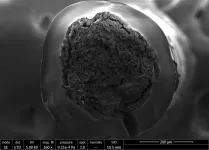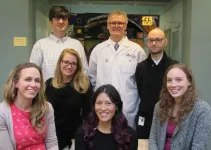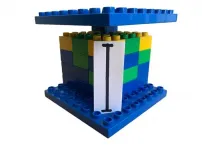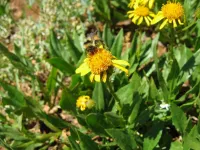(Press-News.org) Tracking carbon dioxide levels indoors is an inexpensive and powerful way to monitor the risk of people getting COVID-19, according to new research from the Cooperative Institute for Research in Environmental Sciences (CIRES) and the University of Colorado Boulder. In any given indoor environment, when excess CO2 levels double, the risk of transmission also roughly doubles, two scientists reported this week in Environmental Science & Technology Letters.
The chemists relied on a simple fact already put to use by other researchers more than a decade ago: Infectious people exhale airborne viruses at the same time as they exhale carbon dioxide. That means CO2 can serve as a "proxy" for the number of viruses in the air.
"You're never safe indoors sharing air with others, but you can reduce the risk," said Jose-Luis Jimenez, co-author of the new assessment, a CIRES Fellow and professor of chemistry at the University of Colorado Boulder.
"And CO2 monitoring is really the only low-cost and practical option we have for monitoring," said Zhe Peng, a CIRES and chemistry researcher, and lead author of the new paper. "There is nothing else."
For many months, researchers around the world have been searching for a way to continually monitor COVID-19 infection risk indoors, whether in churches or bars, buses or hospitals. Some are developing instruments that can detect viruses in the air continually, to warn of a spike or to indicate relative safety. Others tested existing laboratory-grade equipment that costs tens of thousands of dollars.
Jimenez and colleagues turned to commercially available carbon dioxide monitors, which can cost just a few hundred dollars. First, they confirmed in the laboratory that the detectors were accurate. Then, they created a mathematical "box model" of how an infected person exhales viruses and CO2, how others in the room inhaled and exhaled, and how the viruses and gas accumulate in the air of a room or are removed by ventilation. The model takes into consideration infection numbers in the local community, but it does not detail air flow through rooms--that kind of modeling requires expensive, custom analysis for each room.
It's important to understand that there is no single CO2 level at which a person can assume a shared indoor space is "safe," Peng emphasized. That's partly because activity matters: Are people in the room singing and talking loudly or exercising, or are they sitting quietly and reading or resting? A CO2 level of 1,000 ppm, which is well above outside levels of about 400 ppm, could be relatively safe in a quiet library with masks but not in an active gym without masks.
But in each indoor space, the model can illuminate "relative" risk: If CO2 levels in a gym drop from 2,800 to 1,000 ppm (~2,400 above background levels to 600), the risk of COVID-19 transmission drops, too, to one-quarter of the original risk. In the library, if an influx of people makes CO2 jump from 800 to 1,600 (400 to 1,200 above background), COVID transmission risk triples.
In the new paper, Peng and Jimenez also shared a set of mathematical formulae and tools that experts in building systems and public health can use to pin down actual, not just relative, risk. But the most important conclusion is that to minimize risk, keep the CO2 levels in all the spaces where we share air as low as practically possible.
"Wherever you are sharing air, the lower the CO2, the lower risk of infection," Jimenez said.
INFORMATION:
Harmful algal blooms (HABs) occur in all 50 U.S. states and many produce toxins that cause illness or death in humans and commercially important species. However, attempts to place a more exact dollar value on the full range of these impacts often vary widely in their methods and level of detail, which hinders understanding of the scale of their socio-economic effects.
In order to improve and harmonize estimates of HABs impacts nationwide, the National Oceanic and Atmospheric Administration (NOAA) National Center for Coastal Ocean Science (NCCOS) and the U.S. National Office for Harmful Algal Blooms at the Woods Hole Oceanographic Institution (WHOI) convened a workshop led by WHOI Oceanographer ...
Scientists are testing our fundamental understanding of the universe, and there's much more to discover.
What do touch screens, radiation therapy and shrink wrap have in common? They were all made possible by particle physics research. Discoveries of how the universe works at the smallest scale often lead to huge advances in technology we use every day.
Scientists from the U.S. Department of Energy's (DOE) Argonne National Laboratory and Fermi National Accelerator Laboratory, along with collaborators from 46 other institutions and seven countries, are conducting an experiment to put our current understanding of the universe to the test. The first result points to the existence of undiscovered particles or forces. This new physics could help explain long-standing ...
AMHERST Mass. - The long-awaited first results from the Muon g-2 experiment at the U.S. Department of Energy's Fermi National Accelerator Laboratory show fundamental particles called muons behaving in a way that is not predicted by scientists' best theory, the Standard Model of particle physics. This landmark result, made with unprecedented precision and to which UMass Amherst's David Kawall's research group made key contributions, confirms a discrepancy that has been gnawing at researchers for decades.
"Today is an extraordinary day, long awaited ...
Sutures are used to close wounds and speed up the natural healing process, but they can also complicate matters by causing damage to soft tissues with their stiff fibers. To remedy the problem, researchers from Montreal have developed innovative tough gel sheathed (TGS) sutures inspired by the human tendon.
These next-generation sutures contain a slippery, yet tough gel envelop, imitating the structure of soft connective tissues. In putting the TGS sutures to the test, the researchers found that the nearly frictionless gel surface mitigated the damage typically ...
Published in the Proceedings of National Academy of Sciences, researchers in the Climate Intervention Biology Working Group -- including Jessica Hellmann from the University of Minnesota Institute on the Environment -- explored the effect of solar climate interventions on ecology.
Composed of climate scientists and ecologists from leading research universities internationally, the team found that more research is needed to understand the ecological impacts of solar radiation modification (SRM) technologies that reflect small amounts of sunlight back into space. The team focused on a specific proposed SRM strategy -- referred ...
BIRMINGHAM, Ala. - Race associates with the risk of death from end-stage heart failure. So, identifying the molecular determinants of that risk may help the pursuit of the novel diagnosis and prognosis of heart failure, and its therapy.
A University of Alabama at Birmingham study of end-stage heart-failure patients has found that cytosine-p-guanine, or CpG, methylation of the DNA in the heart has a bimodal distribution among the patients, and that race -- African American versus Caucasian -- was the sole variable in patient records that explained the difference. A subsequent ...
More than 20 years after the discovery of the parkin gene linked to young-onset Parkinson's disease, researchers at The Ottawa Hospital and the University of Ottawa may have finally figured out how this mysterious gene protects the brain.
Using human and mouse brain samples and engineered cells, they found that the parkin protein works in two ways. First, it acts like a powerful antioxidant that disarms potentially harmful oxidants in the brain, including dopamine radicals. Second, as the brain ages and dopamine radicals continue to build up, parkin sequesters these harmful molecules in a special storage site within vulnerable nerve cells, so they can continue to ...
CHARLOTTESVILLE, Va. -- If, as the saying goes, less is more, why do we humans overdo so much?
In a new paper featured on the cover of Nature, University of Virginia researchers explain why people rarely look at a situation, object or idea that needs improving -- in all kinds of contexts -- and think to remove something as a solution. Instead, we almost always add some element, whether it helps or not.
The team's findings suggest a fundamental reason that people struggle with overwhelming schedules, that institutions bog down in proliferating red tape, and, of particular ...
Mobility tracking using cell phone data showing greater movement of people is a strong predictor of increased rates of COVID-19, according to new data in CMAJ (Canadian Medical Association Journal).
"This study shows that mobility strongly predicts [severe acute respiratory syndrome coronavirus 2] SARS-CoV-2 growth rate up to 3 weeks in the future, and that stringent measures will continue to be necessary through spring 2021 in Canada," writes Dr. Kevin Brown, Public Health Ontario, with coauthors.
Until Canadians are widely vaccinated against SARS-CoV-2, nonpharmaceutical public health interventions such as physical distancing and limiting social contact will be the main population-based means of controlling the spread of the virus.
"Mobility ...
While studying genetic diversity in bumblebees in the Rocky Mountains, USA, researchers from Uppsala University discovered a new species. They named it Bombus incognitus and present their findings in the journal Molecular Biology and Evolution.
Bumblebees are vital for agriculture and the natural world due to their role in plant pollination. There are more than 250 species of bumblebee, and they are found mainly in northern temperate regions of the planet. Alarmingly, many species are declining due to the effects of climate change, and those with alpine and arctic habitats are particularly threatened. However, the full diversity of bumblebee ...








